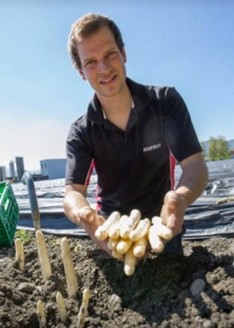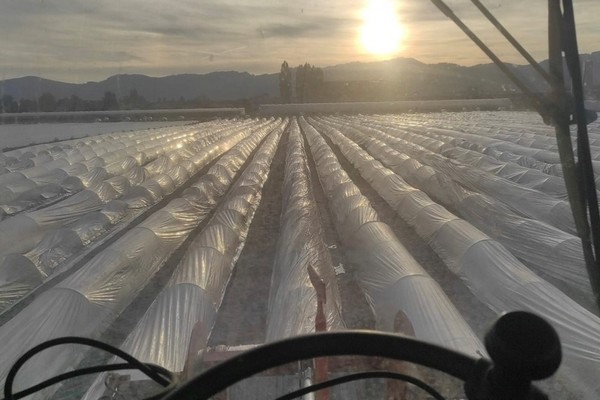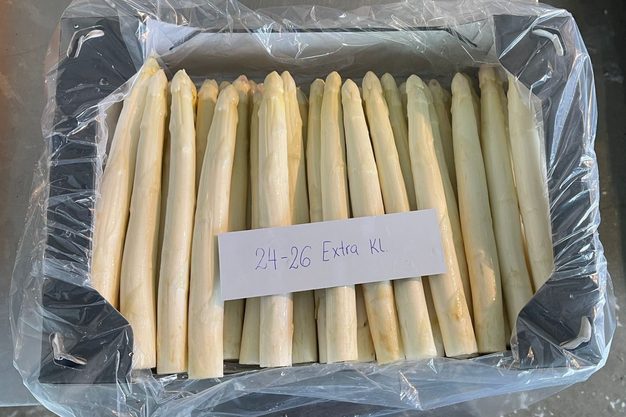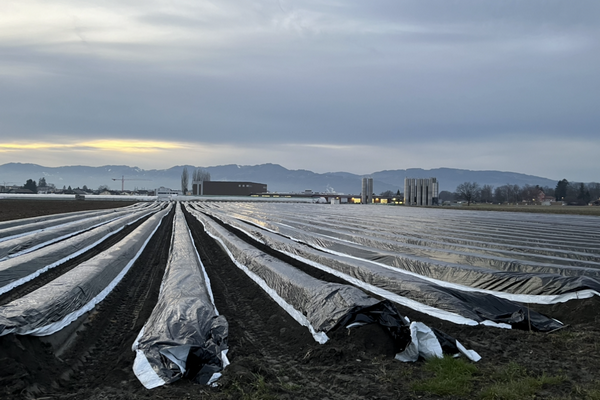 On March 21st, the first Swiss asparagus of the Backlim variety was harvested from heated cultivation at Schmitterhof in the canton of St. Gallen. "The quality of the first harvest is particularly good compared to last year, when we faced quality issues due to the wet month of May. We are currently harvesting about 500 to 600 kilograms of heated asparagus per day on almost 2 hectares, but starting from week 14, we will also begin harvesting in mini tunnels," says owner Fabian Kummer, who cultivates asparagus on a total of 16 hectares.
On March 21st, the first Swiss asparagus of the Backlim variety was harvested from heated cultivation at Schmitterhof in the canton of St. Gallen. "The quality of the first harvest is particularly good compared to last year, when we faced quality issues due to the wet month of May. We are currently harvesting about 500 to 600 kilograms of heated asparagus per day on almost 2 hectares, but starting from week 14, we will also begin harvesting in mini tunnels," says owner Fabian Kummer, who cultivates asparagus on a total of 16 hectares.
Right: Asparagus pioneer Fabian Kummer. The waste heat from the nearby Greiner Packaging company allows the asparagus fields to be heated sustainably. The process enables the Schmitter asparagus to be harvested up to three weeks earlier.
The produce is supplied to both the major distributor Migros via the Forster Group and the gastronomy sector through the marketing partner Marinello at the Zurich wholesale market. Kummer: "About two-thirds of our yield eventually ends up in the gastronomy sector. As a rule, spears with a diameter of up to 22 mm are sold to retail, while the 22+ caliber finds a good response mainly in the gastronomy sector. Generally, the demand for the first Swiss early asparagus is very pleasing, especially in the gastronomy area."

Asparagus in mini tunnel
This is also due to the prices of early asparagus: Currently, Swiss asparagus is priced roughly at the level of the German luxury vegetable. As the season progresses, German asparagus is usually offered at a lower price, while the Swiss product remains almost at the same level. Due to the fact that there are no import quotas for asparagus, unlike many other vegetable products, it is difficult to compete with German imported asparagus in the second half of the season. "Nevertheless, domestic asparagus has gained a high standing over the past years. Even though the self-sufficiency rate in Switzerland remains modest, asparagus is gaining importance, among other things, due to the professionalization of cultivation," Kummer explains.

Large caliber asparagus
The asparagus producer, who is among the most significant in Switzerland, has really invested in early cultivation. "Over the past five years, we have added several early varieties to our portfolio. It should also be mentioned that it can get extremely warm here in the second half of the season, which in turn negatively affects vegetation. Nonetheless, we are generally able to deliver until the end of the season on St. John's Day (June 24th).

Green asparagus is trending
In addition to white asparagus, Schmitterhof also produces green asparagus. The first volumes are expected to be harvested around weeks 15-16, Kummer predicts. "Currently, green asparagus represents about a fifth of our cultivation capacity, but the trend is rising. It is noticeable that white asparagus is mainly used for extensive dishes on weekends, while green asparagus, due to its simple preparation, is also consumed during the week. Furthermore, green asparagus is especially gaining popularity among younger consumers," he concludes.
Images: Schmitterhof
For more information:
Fabian Kummer
Schmitterhof
Alpstrasse 50
9444 Diepoldsau
Switzerland
+41 71 733 11 55
kummer@schmitterhof.ch
www.schmitterhof.ch
